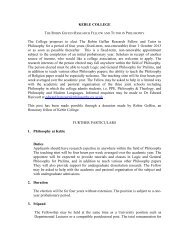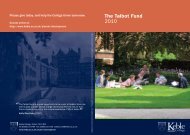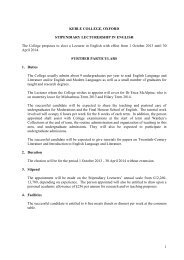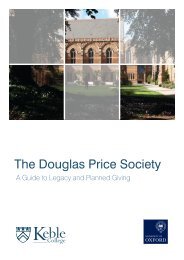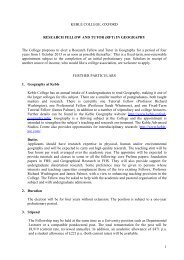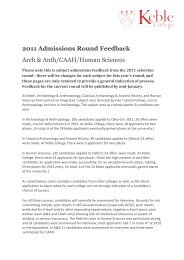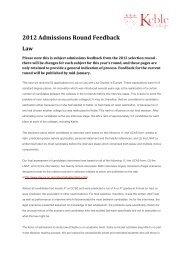The Record 2006 - Keble College - University of Oxford
The Record 2006 - Keble College - University of Oxford
The Record 2006 - Keble College - University of Oxford
Create successful ePaper yourself
Turn your PDF publications into a flip-book with our unique Google optimized e-Paper software.
<strong>The</strong> Life <strong>of</strong> the <strong>College</strong><br />
<strong>The</strong> first church <strong>of</strong> Hagia Sophia in<br />
Constantinople was built in the<br />
fourth century. After the fall <strong>of</strong><br />
Constantinople in 1453, the<br />
magnificent sixth century church –<br />
which still stands today – became a<br />
mosque, and is now a museum.<br />
Averil Cameron, <strong>The</strong> Byzantines<br />
(Blackwells, <strong>Oxford</strong>, November<br />
<strong>2006</strong>)<br />
their rulers were prone to the murder and mutilation <strong>of</strong> rivals, even<br />
within their own families. While their icons are <strong>of</strong>ten beautiful, and<br />
their luxury objects impressive, Byzantine Orthodoxy tends to be<br />
seen outside the Orthodox world as something static and ‘different’,<br />
rather than as a living and varied religious system. Above all,<br />
everyone knows that Constantinople fell to the Ottomans in 1453, and<br />
consciousness <strong>of</strong> this impending event has left an apparently indelible<br />
impression that the last centuries <strong>of</strong> Byzantium must have been marked<br />
by feebleness and decline. It is somewhat ironic that this should be so<br />
when the emergent countries <strong>of</strong> the Balkans their own struggle against<br />
the Ottoman Turks is invested with heroic pride, even when as in the<br />
case <strong>of</strong> Serbia, it was actually unsuccessful.<br />
In my own case, my recent research has taken me from late antiquity to<br />
the later world <strong>of</strong> Byzantium, and especially into its religious history. I<br />
have written on Byzantium in relation to the rise <strong>of</strong> Islam and the Arab<br />
conquests, on the controversy about religious images in the seventh<br />
and eighth centuries, and on perceptions <strong>of</strong> orthodoxy and heresy in<br />
Byzantium. I had already moved into Byzantium in my teaching before<br />
I moved to <strong>Oxford</strong>, and once here I gave the introductory lectures<br />
for graduates on Byzantine history for the <strong>University</strong>. In my view the<br />
cultural or religious history <strong>of</strong> pre-modern periods can only be written<br />
if it is firmly grounded in an understanding <strong>of</strong> the social, political<br />
and economic fabric, and my experience <strong>of</strong> lecturing on the subject<br />
led me to believe that the history <strong>of</strong> the Byzantine state was far more<br />
dynamic than the usual stereotypes allow. Edward Gibbon did most<br />
for English-speaking readers to convey the impression <strong>of</strong> Byzantium as<br />
a weak successor to the classical world and the Roman empire (though<br />
he was preceded by others including Montesquieu) and this image is<br />
still likely to be the only impression <strong>of</strong> Byzantium with which most<br />
people come into contact. My recent work aims in a way to normalize<br />
Byzantium by showing first that like any other long-lived state, its<br />
history was complex and varied, even in the key areas <strong>of</strong> court life and<br />
religion, and second, that the history <strong>of</strong> Byzantium was an integral part<br />
<strong>of</strong> the wider history <strong>of</strong> Europe and the Mediterranean. It cannot be left<br />
aside as something exotic and different, or understood only through<br />
the fascination <strong>of</strong> the icon exhibitions that currently draw such large<br />
audiences.<br />
Writing the book on Byzantium for Blackwells in the series <strong>The</strong><br />
Peoples <strong>of</strong> Europe was a way <strong>of</strong> preparing for a larger project currently<br />
in the planning stage. <strong>The</strong> Byzantines has two broadly chronological<br />
chapters but is otherwise arranged thematically, so that it can address<br />
fundamental historical questions about the Byzantine state over the<br />
entire period. <strong>The</strong> title follows those <strong>of</strong> other volumes in the same<br />
series, but in fact the Byzantines were not a people in any ethnic sense.<br />
<strong>The</strong> very term ‘Byzantine’ was given to them only in the sixteenth<br />
15




